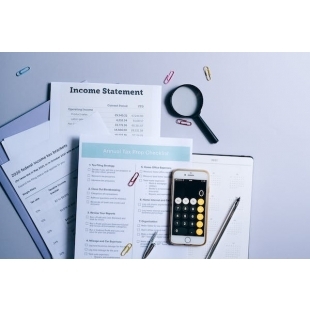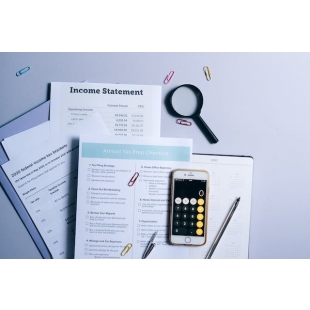All News
-

All income is taxable, including gig economy and tip income
IRS Tax Tip 2023-42, March 30, 2023
It's important for taxpayers to file a federal tax return that has a complete and correct reporting of their income – which may mean including income from sources other than regular wages from an employer. Income from gig economy activities and tip income are two common sources of such income.
Gig economy earnings are taxable
The gig economy is activity where people earn income providing on-demand work, services or goods, such as selling goods online, driving a car for deliveries or renting out property. This income is often received through a digital platform like an app or website.
Taxpayers must report income earned from the gig economy on a tax return, even if the income is:
From part-time, temporary or side work.
Paid in any form, including cash, property, goods or digital assets
Not reported on an information return form like a Form 1099-K, 1099-MISC, W-2 or other income statement.
For more information taxpayers should visit the gig economy tax center page of IRS.gov.
Reporting service industry tips
People who work in restaurants, salons, hotels and similar service industries often receive tips for the customer service they provide. Tips are generally taxable income, and it's important for people working in these areas who regularly receive tips to understand the requirements on reporting tips.
Tips are optional cash or noncash payments customers make to employees.
Cash tips include those received directly from customers, electronically paid tips distributed to the employee by their employer and tips received from other employees under any tip-sharing arrangement. All cash tips must be reported to the employer, who must include them on the employee's Form W-2, Wage and Tax Statement.
Noncash tips are those of value received in any medium other than cash, such as: tickets, passes or other goods or commodities a customer gives the employee. Employees don't report noncash tips to their employer, but they must report the value of them on a tax return.
Any cash tips the employee didn't report to the employer must be reported separately on Form 4137, Social Security and Medicare Tax on Unreported Tip Income, to include as additional wages with their tax return. The employee must also pay the employee share of Social Security and Medicare tax owed on those tips.
Employees don't have to report tip amounts of less than $20 per month per employer. For larger amounts, employees must report tips to the employer by the 10th of the month following the month they received the tips.
The employee can use Form 4070, Employee's Report of Tips to Employer, available in Publication 1244, Employee's Daily Record of Tips and Report to Employer, or they can use an employer-provided form or other electronic system used by their employer.
For more information on how to report tips taxpayers should review the Tip Recordkeeping and Reporting page of IRS.gov
Share this tip on social media -- #IRSTaxTip: All income is taxable, including gig economy and tip income. http://ow.ly/XjaX50NuHip
Resource: https://www.irs.gov/newsroom/all-income-is-taxable-including-gig-economy-and-tip-incomeAll income is taxable, including gig economy and tip incomemore -

Important details to understand when the IRS might contact a taxpayer
Issue Number: IR-2023-56
Inside This Issue
WASHINGTON – The Internal Revenue Service reaches out in multiple ways to educate taxpayers while ensuring it fairly enforces the nation’s tax laws. There are important factors to keep in mind about when the IRS may initiate direct contact with a taxpayer.
For people who owe taxes, the IRS provides many different payment options to help taxpayers meet their obligations. Taxpayers can avoid late filing and interest penalties by submitting their tax return and using one of these options to pay what they owe by April 18.
For those struggling to pay in full by the deadline, the IRS offers several different options. For example, most individual taxpayers qualify for a payment plan and can use the IRS’ Online Payment Agreement to set up a payment plan (including an installment agreement) to pay off an outstanding balance over time.
People encountering a tax issue, such as an unpaid bill or a question about their taxes, will typically receive multiple letters in the mail from the IRS. People are encouraged to respond to these letters quickly, since interest and penalties can compound quickly.
Most IRS contacts with taxpayers are through regular mail delivered by the United States Postal Service. However, there are limited circumstances when the IRS will come to a home or business as part of a collection investigation, an audit or an ongoing criminal investigation.
IRS in-person visits
IRS employees that may make face-to-face visits outside an IRS office include revenue officers, revenue agents and IRS Criminal Investigation special agents. IRS employees are trained to respect taxpayer rights, and there are some important facts to keep in mind about the different types of visits.
Revenue officers are IRS civil enforcement employees who work to resolve compliance issues such as unfiled returns and/or taxes owed – all situations where the taxpayer typically would have received multiple IRS letters in advance.
These in-person visits may be unscheduled and can be to share information, inform taxpayers of their tax filing and payment obligations and work with taxpayers to resolve their tax issues and bring them into compliance.
They conduct interviews to gather financial information and provide taxpayers with the necessary steps to become and remain compliant with the tax laws.
Revenue agents usually conduct in-person field audits that are normally at the taxpayer's home, place of business or accountant's office where the organization’s financial books and records are located. Revenue agents will make contact via mail or phone prior to any visit.
Revenue officers and agents always carry two forms of official credentials with a serial number and their photo. Taxpayers have the right to see each of these credentials and can also request an additional method to verify their identification.
Remember, taxpayers should know they have a tax issue before these visits occur since multiple mailings occur.
More information on identifying legitimate IRS representatives and how to report scams can be found at IRS.gov.
IRS-CI special agents investigate potential criminal violations of the Internal Revenue Code and related financial crimes. IRS-CI’s investigative jurisdiction includes tax, money laundering and Bank Secrecy Act laws. IRS-CI special agents always present their law enforcement credentials when conducting investigations.
IRS-CI may visit a taxpayer’s home or business unannounced during an investigation. However, they will not demand any sort of payment. Learn more about IRS-CI on IRS.gov.
How to report impersonation scams
If a person doesn’t have a previously known tax issue and suspects someone is trying to impersonate an IRS employee, there are a variety of options to report phone, email and other impersonation scams:
Report impersonation scams to the Treasury Inspector General for Tax Administration on the IRS Impersonation Scam Reporting Taxpayers can also call 800-366-4484 to report impersonation scams.
Protect your community by reporting fraud, scams and bad business practices. Report phone scams to the Federal Trade Commission at Report Fraud FTC.
Report an unsolicited email claiming to be from the IRS or an IRS-related system like the Electronic Federal Tax Payment System to the IRS at phishing@irs.gov.
For a comprehensive listing of recent tax scams, consumer alerts and how to report them, visit Tax Scams/Consumer Alerts.
Resource: https://www.irs.gov/newsroom/important-details-to-understand-when-the-irs-might-contact-a-taxpayerImportant details to understand when the IRS might contact a taxpayermore -

What taxpayers should do when they receive Form 1099-K
IRS Tax Tip 2023-37, March 22, 2023
Form 1099-K, Payment Card and Third Party Network Transactions, is an IRS form that is used to report certain payment transactions.
If taxpayers receive a Form 1099-K, they should use that information with their other tax records to determine their correct tax liability. Taxpayers must report all their income on their tax return unless it's excluded by law, regardless of whether they receive a Form 1099-K.
Taxpayers will receive Form 1099-K for business transactions, including income from:
A business the taxpayer owns.
Self-employment.
Activities in the gig economy.
The sale of personal items and assets.
Money received as a gift or for reimbursement does not require a 1099-K. Taxpayers can minimize the chance of an error by asking friends or family members to correctly designate that type of payment as a non-business-related transaction. The taxpayer should also make a note of what the payment was for and who sent it. Good recordkeeping is key.
What to do when a Form 1099-K is incorrect
Some taxpayers may have received a Form 1099-K for the sale of personal items, or Form 1099-K may have been issued in error – such as for transactions between friends and family, or expense sharing.
If the information is incorrect on the Form 1099-K, taxpayers should contact the issuer immediately. The issuing organization's name appears in the upper left corner on the form. Taxpayers should keep a copy of all correspondence with the issuer for their records.
If a taxpayer receives a Form 1099-K in error and the taxpayer cannot obtain a corrected Form 1099-K, the taxpayers should follow the IRS' updated guidance at Understanding Your Form 1099-K.
1099-K reporting threshold for tax year 2023
The American Rescue Plan of 2021 changed the reporting threshold requirement for payment apps, also known as third-party settlement organizations. The IRS announced that the new Form 1099-K reporting threshold will start in tax year 2023.
The old threshold was $20,000 and 200 transactions per year. This applies to tax year 2022 and prior years.
The new threshold is more than $600. This applies to tax year 2023 and future years.
The threshold change means some people may receive a Form 1099-K who have not received one in the past. There are no changes to what counts as income or how tax is calculated.
US TAX, U.S. TAX
Resource: https://www.irs.gov/newsroom/what-taxpayers-should-do-when-they-receive-form-1099-kWhat taxpayers should do when they receive Form 1099-Kmore -

Subject Tax Stats Dispatch: 2020 Information Returns, Line Item Estimates (Publication 5385), High-Income Tax Returns, Tax Year 2019, Individual Noncash Charitable Contributions, Tax Year 2020, Notice of Data Revision, Notice of Revised Release Dates
Issue Number: 2023-003
Inside This Issue
2020 Individual Information Returns, Line Item Estimates (Publication 5385)
High-Income Tax Returns, Tax Year 2019
Noncash Charitable Contributions, Tax Year 2020
Notice of Data Revision
Notice of Revised Release Dates
1. 2020 Individual Information Returns, Line Item Estimates (Publication 5385)
The 2020 Statistics of Income (SOI) Publication 5385, Individual Information Returns, Line Item Estimates, is now available on SOI's Tax Stats webpage. The publication provides estimates of frequencies and amounts of the entries on the lines of the forms filed for selected information returns that accompany the 2020 SOI Individual Complete Report weighted file. The estimates are based on returns filed in Processing Year 2021 that were sampled statistically and then weighted to estimate the entire 2020 Tax Year.
2. High-Income Tax Returns, Tax Year 2019
Detailed data on individual income tax returns with adjusted gross income or expanded income greater than $200,000 are now available on SOI's Tax Stats webpage. This annual study also looks at high-income, nontaxable returns (HINTs) and the reason for nontaxability. For 2019, there were just under 9.2 million individual income tax returns with an expanded income of $200,000 or more, accounting for 5.8 percent of all returns for the year. Of these, 7,391 returns had no worldwide income tax liability. This was a 2.6-percent increase over the number of returns with no worldwide income tax liability for 2018. It was only the third increase in the past 10 years, and well below the peak of 19,551 returns for 2009.
3. Noncash Charitable Contributions, Tax Year 2020
Five tables presenting data for all individual income tax returns that reported noncash charitable contributions for Tax Year 2020 on Noncash Charitable Contributions (Form 8283) are now available on SOI's Tax Stats webpage. These tables are also based on data reported on U.S. Individual Income Tax Return (Form 1040) and Itemized Deductions (Schedule A). The data detail the number of returns, number of donations, donor's cost, fair market value, and amount carried to Schedule A. Data are categorized by donation type, donor type, size of adjusted gross income, and donor age.
4. Notice of Data Revision
Selected items on the Tax Year 2019 Schedule K-1 (Form 1065), Partner's Share of Income, Deductions, Credits, etc., in the 2019 Individual Information Returns, Line Item Estimates (Publication 5385), have been updated. Some data items were placed on the wrong lines. In the revision, they have been moved to the correct lines and are now available on SOI's Tax Stats webpage.
5. Notice of Revised Release Dates
April 27: Tax-Exempt Organizations Unrelated Business Income Tax, Tax Year 2017
April 27: Individuals, Migration flow data, 2020-2021
April 27: Individual Retirement Arrangement (IRA) Information, Tax Year 2020
May 18: Individuals, Advance Data, Tax Year 2021
For more information on Federal Taxes please visit IRS.gov.
US TAX, U.S. TAX
Resource: https://www.irs.gov/statistics/soi-tax-stats-individual-income-tax-returns-line-item-estimates-publication-4801
https://www.irs.gov/statistics/soi-tax-stats-individual-high-income-tax-returns
https://www.irs.gov/statistics/soi-tax-stats-individual-noncash-charitable-contributions
https://www.irs.gov/statistics/soi-tax-stats-individual-income-tax-returns-line-item-estimates-publication-4801
https://www.irs.gov/statistics/soi-tax-stats-whats-newSubject Tax Stats Dispatch: 2020 Information Returns, Line Item Estimates (Publication 5385), High-Income Tax Returns, Tax Year 2019, Individual Noncash Charitable Contributions, Tax Year 2020, Notice of Data Revision, Notice of Revised Release Datesmore -

Some things taxpayers getting ready to file should know
IRS Tax Tip 2023-33, March 14, 2023
With the 2023 tax filing season in full swing, taxpayers should be sure to visit IRS.gov for updated resources and tools to help with their 2022 tax return.
Things to know before filing
Taxpayers should wait to file until they receive all their proper tax documents, or they risk making a mistake that could cause delays.
They should also review their income documents carefully. If any of the information is inaccurate or missing, taxpayers should contact the payer right away for a correction or to ensure the issuer has their current mailing or email address.
Creating an IRS Online Account can help taxpayers securely access information about their federal tax account, including payments, tax records and more.
Organized tax records make preparing a complete and accurate tax return easier and may help taxpayers find overlooked deductions or credits.
Taxpayers with an Individual Taxpayer Identification Number or ITIN may need to renew it if it's expired and is needed on a U.S. federal tax return. If they don't renew an expiring or expired ITIN, the IRS can still accept their return, but it may delay processing or credits owed.
Taxpayers should visit IRS.gov for information and answers to common tax questions
The IRS Interactive Tax Assistant helps taxpayers find answers tax questions based on their specific circumstances. Taxpayers can use it to determine if they must file a tax return, their filing status, if they can claim a dependent, if the type of income they have is taxable, if they're eligible to claim a credit or if they can deduct expenses.
IRS Tax Topics contain general individual and business tax information. If taxpayers don't find the answers to their question, they can check Frequently Asked Questions.
The Let Us Help You page lists many other online resources.
Taxpayers can find IRS forms, instructions and publications they need to file tax return at Forms, Instructions & Publications.
Once a taxpayer has filed their return, they can track the status of their return with the Where's My Refund? tool at IRS.gov/wheresmyrefund.
Subscribe to IRS Tax Tips
US TAX, U.S. TAX
Resource:https://www.irs.gov/newsroom/some-things-taxpayers-getting-ready-to-file-should-knowSome things taxpayers getting ready to file should knowmore -

Tax Time Guide: Using electronic payment and agreement options for taxpayers who owe can help avoid penalties and interest
IR-2023-44, March 9, 2023
WASHINGTON ― With the tax deadline approaching, the IRS reminded taxpayers they can avoid late filing and interest penalties by submitting their tax return and any payments due by April 18. For struggling taxpayers who can't pay by the deadline, the IRS offers several different options to help.
The IRS also provides multiple ways for people to file for an extension, get information to help file their tax return and learn about payment options if they have trouble paying by the April 18 deadline.
Eligible individuals and families who earned $73,000 or less in 2022 can use IRS Free File, available only on IRS.gov, to electronically file their taxes. All taxpayers, regardless of income, who need more time to file a return can use IRS Free File as an easy and quick way to electronically file for a six-month extension before April 18, 2023. An extension will help to avoid penalties and interest for failing to file on time, and gives taxpayers until Oct. 16, 2023, to file. However, they still must pay what they owe by the April 18 deadline.
Except for eligible victims of recent natural disasters who have until Oct. 16 to make various tax payments, taxpayers who can't pay the full amount of taxes they owe by April 18 should file and pay what they can to reduce total penalties and interest.
There are several ways to make electronic payments, and there are options for a payment plan or agreement.
IRS Online Account
An IRS Online Account provides access to important information when preparing to file a tax return, pay a balance or follow up on notices. Taxpayers can view their:
Adjusted Gross Income.
Payment history and any scheduled or pending payments.
Payment plan details.
Digital copies of select notices from the IRS.
Taxpayers can also use their Online Account to securely make a same-day payment for an outstanding 2022 tax balance, pay quarterly estimated taxes for the 2023 tax season or request an extension to file a 2022 return.
Interest and a late payment penalty will apply to any payments made after April 18. Making a payment, even a partial payment, will help limit penalty and interest charges.
Other options to pay electronically
Direct Pay, available only on IRS.gov, is the fastest and easiest way to make a one-time payment without signing into an IRS Online Account.
Direct Pay: Direct Pay is free and allows taxpayers to securely pay their federal taxes directly from their checking or savings account without any fees or preregistration. Taxpayers can schedule payments up to 365 days in advance. After submitting a payment through Direct Pay, taxpayers will receive immediate confirmation.
Electronic Funds Withdrawal (EFW): This option allows taxpayers to file and pay electronically from their bank account when using tax preparation software or a tax professional. This option is free and only available when electronically filing a tax return.
Electronic Federal Tax Payment System: This free service gives taxpayers a safe and convenient way to pay individual and business taxes by phone or online. To enroll and for more information, taxpayers can call 800-555-4477 or visit eftps.gov.
Debit or credit card or digital wallet: Individuals can pay online, by phone or with a mobile device through any of the authorized payment processors. The processor charges a fee. The IRS doesn't receive any fees for these payments. Authorized card processors and phone numbers are available at IRS.gov/payments.
Other payment options:
Cash: For taxpayers who prefer to pay in cash, the IRS offers a way to pay taxes at one of its Cash Processing Company services. The IRS urges taxpayers choosing this option to start early because it involves a four-step process. Details, including answers to frequently asked questions, are at IRS.gov/paywithcash.
Check or money order: Payments made by check or money order should be made payable to the "United States Treasury." To help ensure that the payment gets credited promptly, taxpayers should also enclose a 2022 Form 1040-VPDF payment voucher and print the following on the front of the check or money order:
"2022 Form 1040"
Name
Address
Daytime phone number
Social Security number
For taxpayers who cannot pay in full
The IRS encourages taxpayers who cannot pay in full to pay what they can and consider a variety of payment options available for the remaining balance including getting a loan to pay the amount due. In many cases, loan costs may be lower than the combination of interest and penalties the IRS must charge under federal law. Taxpayers should act as quickly as possible: Tax bills accumulate more interest and fees the longer they remain unpaid. For all payment options, visit IRS.gov/payments.
Online self-service payment plans
Most individual taxpayers qualify for a payment plan and can use Online Payment Agreement to set up a payment plan (including an installment agreement) to pay off an outstanding balance over time.
Once the online application is completed, the taxpayer receives immediate notification of whether their payment plan has been approved. Taxpayers can setup a plan using the Online Payment Agreement in a matter of minutes. There's no paperwork and no need to call, write or visit the IRS. Setup fees may apply for some types of plans.
Online payment plan options for individual taxpayers include:
Short-term payment plan – The total balance owed is less than $100,000 in combined tax, penalties and interest. Additional time of up to 180 days to pay the balance in full.
Long-term payment plan (installment agreement) – The total balance owed is less than $50,000 in combined tax, penalties and interest. Pay in monthly payments for up to 72 months. Payments may be set up using direct debit (automatic bank withdraw) which eliminates the need to send in a payment each month, saving postage costs, and reducing the chance of default. For balances between $25,000 and $50,000, direct debit is required.
Qualified taxpayers with existing payment plans may be able to use the Online Payment Agreement to make changes including revising payment dates, payment amounts or bank information for payments made by direct debit. Go to Online Payment Agreement for more information.
Though interest and late-payment penalties continue to accrue on any unpaid taxes after April 18, the failure to pay the tax penalty rate is cut in half while an installment agreement is in effect. Find more information about the costs of payment plans on the IRS' Additional Information on Payment Plans webpage.
Other payment options
Taxpayers struggling to meet their tax obligation may also consider these additional payment options:
Offer in Compromise – Certain taxpayers qualify to settle their tax liabilities for less than the total amount they owe by submitting an Offer in Compromise. To help determine their eligibility, they can use the Offer in Compromise Pre-Qualifier tool. To help taxpayers prepare their own valid Offers in Compromise, the IRS created an Offer in Compromise video playlist – also available in Spanish and Simplified Chinese – that walks them through the necessary paperwork.
Temporary delay of collection – Taxpayers can contact the IRS to request a temporary delay of the collection process. If the IRS determines a taxpayer is unable to pay, it may delay collection until the taxpayer's financial condition improves. Penalties and interest continue to accrue until the full amount is paid.
Other payment plan options – Taxpayers who do not qualify for online self-service should contact the IRS using the phone number or address on their most recent notice for other payment plan options. For individuals and out-of-business sole proprietors who are already working with IRS Campus Collection and who owe $250,000 or less, one available option is to propose a monthly payment that will pay the balance over the length of the Collection Statute (usually 10 years). These payment plans don't require a financial statement, but they do require a determination for the filing of a Notice of Federal Tax Lien still applies.
For more information about payments, see Topic No. 202, Tax Payment Options, on IRS.gov.
Taxpayer Rights
The IRS reminds taxpayers that they have rights and protections throughout the collection process. For details, see Taxpayer Bill of Rights and Publication 1, Your Rights as a TaxpayerPDF.
Taxpayers should know before they owe. The IRS encourages all taxpayers to check their withholding with the IRS Tax Withholding Estimator.
This news release is part of a series called the Tax Time Guide, a resource to help taxpayers file an accurate tax return. Additional help is available in Publication 17, Your Federal Income Tax.
US TAX, U.S. TAX
Resource:https://www.irs.gov/newsroom/tax-time-guide-using-electronic-payment-and-agreement-options-for-taxpayers-who-owe-can-help-avoid-penalties-and-interestTax Time Guide: Using electronic payment and agreement options for taxpayers who owe can help avoid penalties and interestmore -

Taxpayers should know that an extension to file is not an extension to pay taxes
IRS Tax Tip 2023-30, March 8, 2023
Taxpayers who aren't able to file by the April 18, 2023, deadline can request an extension before that deadline, but they should know that an extension to file is not an extension to pay taxes. If they owe taxes, they should pay them before the due date to avoid potential penalties and interest on the amount owed.
Taxpayers who request a six-month extension to file their taxes have until October 16, 2023, to file their 2022 federal income tax return.
How to request a free extension to file for a return with no tax due
Individual taxpayers, regardless of income, can use IRS Free File at IRS.gov/freefile to request an automatic six-month tax-filing extension. Alternatively, taxpayers can file Form 4868, Application for Automatic Extension of Time to File.
How to request an extension when making a payment for a return with taxes due
Taxpayers can choose to submit an electronic payment and select Form 4868 or extension as the payment type. The IRS will count it as an extension automatically, and taxpayers won't need to file Form 4868
Victims in FEMA disaster areas may have an automatic extension
The IRS may offer an automatic extension to areas designated by the Federal Emergency Management Agency. To check whether an area is included, see Tax Relief in Disaster Situations. Taxpayers in the affected areas do not need to file any extension paperwork, and they do not need to call the IRS to qualify for the extended time.
U.S. citizens and resident aliens abroad and military members in combat zones may have more time to pay
Taxpayers living overseas, including members of the military and eligible support personnel serving in combat zones may also have extra time to file their tax returns and pay any taxes due.
More information:
What Is the Due Date of My Federal Tax Return or Am I Eligible to Request an Extension?
Source: https://www.irs.gov/newsroom/taxpayers-should-know-that-an-extension-to-file-is-not-an-extension-to-pay-taxes
US TAX, U.S. TAXTaxpayers should know that an extension to file is not an extension to pay taxesmore -

The IRS offers easy and convenient options to make federal tax payments
IRS Tax Tip 2023-28, March 6, 2023
Anyone who needs to pay their federal tax bill has several ways to send a payment to IRS quickly and securely. Knowing the options to make payments helps taxpayers meet their tax obligations.
Here are several ways people who owe taxes can pay it. They can:
Pay when they e-file using electronic funds withdrawal to draw the payment directly from their bank account.
Sign into their Online Account to pay their 2022 balance or make estimated tax payments. Taxpayers can also see their payment history, any scheduled or pending payments, and other account details.
Use IRS Direct Pay to pay electronically directly from their checking or savings account. They can choose to receive email notifications about their payments when they pay this way
Pay using a payment processor by credit card, debit card or digital wallet. Taxpayers can make these payments online for a fee.
Make a cash payment at more than 60,000 participating retail locations nationwide. To pay with cash, taxpayers should visit IRS.gov and follow the instructions.
Pay over time by applying for an online payment agreement. Once the IRS accepts an agreement, taxpayers can make their payment in monthly installments.
For details on these options, people can visit IRS.gov/payments.
Estimated taxes
Some taxpayers must make quarterly estimated tax payments throughout the year. This includes individuals, sole proprietors, partners, and S corporation shareholders who expect to owe $1,000 or more when they file. Individuals who participate in the gig economy might also have to make estimated payments.
Source: https://www.irs.gov/newsroom/the-irs-offers-easy-and-convenient-options-to-make-federal-tax-payments
US TAX, U.S. TAXThe IRS offers easy and convenient options to make federal tax paymentsmore -

Tax Time Guide: IRS reminder to report all income; gig economy and service industry, digital or foreign assets and sources
IR-2023-35, March 1, 2023
WASHINGTON — The Internal Revenue Service reminds taxpayers of their reporting and potential tax obligations on income from the gig economy and service industry, transactions from digital assets, and foreign sources or holding certain foreign assets.
Information available on IRS.gov and Instructions for Form 1040 and Form 1040-SR can help taxpayers understand and meet these reporting and tax requirements.
Gig economy earnings are taxable
Generally, income earned from the gig economy is taxable and must be reported to the IRS on tax returns.
The gig economy is activity where people earn income providing on-demand work, services or goods, such as selling goods online, driving a car for deliveries or renting out property. Often, it's through a digital platform like an app or website.
Taxpayers must report income earned from the gig economy on a tax return, even if the income is:
From part-time, temporary or side work.
Paid in any form, including cash, property, goods or digital assets
Not reported on an information return form like a Form 1099-K, 1099-MISC, W-2 or other income statement.
For more information on the gig economy, visit the gig economy tax center.
Service industry tips are also taxable
People who work in restaurants, salons, hotels and similar service industries often receive tips for the customer service they provide. Tips are usually taxable income, and it's important for people working in these areas to understand details on how to report tips.
Tips are optional cash or noncash payments customers make to employees.
Cash tips include those received directly from customers, electronically paid tips distributed to the employee by their employer and tips received from other employees under any tip-sharing arrangement. All cash tips must be reported to the employer, who must include them on the employee's Form W-2, Wage and Tax Statement.
Noncash tips are those of value received in any other medium than cash, such as: tickets, passes or other goods or commodities a customer gives the employee. Noncash tips aren't reported to the employer but must be reported on a tax return.
Any tips the employee didn't report to the employer must be reported separately on Form 4137, Social Security and Medicare Tax on Unreported Tip Income, to include as additional wages with their tax return. The employee must also pay the employee share of Social Security and Medicare tax owed on those tips.
Employees don't have to report tip amounts of less than $20 per month per employer. For larger amounts, employees must report tips to the employer by the 10th of the month following the month the tips were received.
The employee can use Form 4070, Employee's Report of Tips to Employer, available in Publication 1244, Employee's Daily Record of Tips and Report to Employer, an employer-provided form or other electronic system used by their employer.
For more information on how to report tips see Tip Recordkeeping and Reporting.
Understand digital asset reporting and tax requirements
The IRS reminds taxpayers that there's a question at the top of Forms 1040 and 1040-SR that asks about digital asset transactions. All taxpayers filing these forms must check the box indicating either "yes" or "no."
If an individual disposed of any digital asset that was held as a capital asset through a sale, exchange or transfer, they should check "Yes" and use Form 8949, Sales and other Dispositions of Capital Assets, to figure their capital gain or loss and report it on Schedule D (Form 1040), Capital Gains and Losses, or Form 709, United States Gift (and Generation-Skipping Transfer) Tax Return, in the case of a gift.
Examples of transactions involving digital assets include:
A sale of digital assets.
The receipt of digital assets as payment for goods or services provided.
The receipt or transfer of digital assets for free (without providing any consideration) that does not qualify as a bona fide gift.
The receipt of new digital assets as a result of mining and staking activities.
The receipt of new digital assets as a result of a hard fork.
An exchange of digital assets for property, goods or services.
An exchange/trade of digital assets for another digital asset(s).
Any other disposition of a financial interest in digital assets.
If individuals received any digital assets as compensation for services or disposed of any digital assets they held for sale to customers in a trade or business, they must report the income as they would report other income of the same type (for example, W-2 wages on Form 1040 or 1040-SR, line 1a, or inventory or services on Schedule C).
More information on digital assets can be found in the Instructions for Form 1040 and 1040-SR and on the IRS' Digital Assets page.
Report foreign source income
A U.S. citizen or resident alien's worldwide income is generally subject to U.S. income tax, regardless of where they live. They're also subject to the same income tax filing requirements that apply to U.S. citizens or resident aliens living in the United States.
U.S. citizens and resident aliens must report unearned income, such as interest, dividends and pensions from sources outside the United States unless exempt by law or a tax treaty. They must also report earned income, such as wages and tips, from sources outside the United States.
An income tax filing requirement generally applies even if a taxpayer qualifies for tax benefits, such as the Foreign Earned Income Exclusion or the Foreign Tax Credit, which substantially reduce or eliminate U.S. tax liability. These tax benefits are available only if an eligible taxpayer files a U.S. income tax return.
A taxpayer is allowed an automatic two-month extension to June 15 if both their tax home and abode are outside the United States and Puerto Rico. Even if allowed an extension, a taxpayer will have to pay interest on any tax not paid by the regular due date of April 18, 2023.
Those serving in the military outside the U.S. and Puerto Rico on the regular due date of their tax return also qualify for the extension to June 15. IRS recommends attaching a statement if one of these two situations applies. More information can be found in the Instructions for Form 1040 and Form 1040-SR, Publication 54, Tax Guide for U.S. Citizens and Resident Aliens Abroad and Publication 519, U.S. Tax Guide for Aliens.
Reporting required for foreign accounts and assets
Federal law requires U.S. citizens and resident aliens to report their worldwide income, including income from foreign trusts and foreign bank and other financial accounts. In most cases, affected taxpayers need to complete and attach Schedule B (Form 1040), Interest and Ordinary Dividends, to their tax return. Part III of Schedule B asks about the existence of foreign accounts such as bank and securities accounts and usually requires U.S. citizens to report the country in which each account is located.
In addition, certain taxpayers may also have to complete and attach to their return Form 8938, Statement of Foreign Financial Assets. Generally, U.S. citizens, resident aliens and certain nonresident aliens must report specified foreign financial assets on this form if the aggregate value of those assets exceeds certain thresholds. See the instructions for this form for details.
Further, separate from reporting specified foreign financial assets on their tax return, U.S. persons with an interest in or signature or other authority over foreign financial accounts where the aggregate value exceeded $10,000 at any time during 2022 must file electronically with the Treasury Department a Financial Crimes Enforcement Network (FinCEN) Form 114, Report of Foreign Bank and Financial Accounts (FBAR). Because of this threshold, the IRS encourages U.S. persons with foreign assets, even relatively small ones, to check if this filing requirement applies to them. The form is available only through the BSA E-filing System website.
The deadline for filing the annual Report of Foreign Bank and Financial Accounts (FBAR) is April 15, 2023. FinCEN grants U.S. persons who miss the original deadline an automatic extension until Oct. 15, 2023, to file the FBAR. There is no need to request this extension. See FinCEN'sPDF website for further information.
This news release is part of a series called the Tax Time Guide, a resource to help taxpayers file an accurate tax return. Additional guidance is available in Publication 17, Your Federal Income Tax (For Individuals).
Source: https://www.irs.gov/newsroom/tax-time-guide-irs-reminder-to-report-all-income-gig-economy-and-service-industry-digital-or-foreign-assets-and-sources
US TAX, U.S. TAXTax Time Guide: IRS reminder to report all income; gig economy and service industry, digital or foreign assets and sourcesmore -

What to do when a W-2 or Form 1099 is missing or incorrect
IRS Tax Tip 2023-25, February 28, 2023
It's important for taxpayers to have all their documents and information so they can file an accurate and complete tax return. This may mean waiting to file until they receive all their documentation – and it can also mean following up on missing or incorrect documents.
Most taxpayers should have received income documents near the end of January. These may include:
Form W-2, Wage and Tax Statement
Form 1099-MISC, Miscellaneous Income
Form 1099-INT, Interest Income
Form 1099-NEC, Nonemployee Compensation
Form 1099-G, Certain Government Payments; like unemployment compensation or state tax refund
Taxpayers should first contact the employer, payer or issuing agency directly for copies
Taxpayers who haven't received a W-2 or Form 1099 should contact the employer, payer or issuing agency and request a copy of the missing document or a corrected document.
If they can't get a copy, they can contact the IRS for help
Taxpayers should file their tax return on time – this year's tax deadline is April 18 for most filers – even if they still have missing or incorrect documents. If they don't receive the missing or corrected form from their employer or payer by the end of February, they may call the IRS at 800-829-1040 for help. They'll need to provide their name, address, phone number, Social Security number and dates of employment. They'll also need to provide the employer's or payer's name, address and phone number. The IRS will contact the employer or payer and request the missing form.
Estimating income when forms are incorrect or missing
After the taxpayer contacts the IRS about missing documents, the IRS will send the taxpayer one of these forms:
Form 4852, Substitute for Form W-2, Wage and Tax Statement or Form 1099-R, Distributions From Pensions, Annuities, Retirement or Profit-Sharing Plans, IRAs, Insurance Contracts, Etc.
If the taxpayer doesn't receive the missing form in time to file their income tax return by the filing due date, they may complete Form 4852 or Form 1099-R to estimate their wages and earnings. They then attach the relevant form to their tax return when they file.
Taxpayers may need to file an amended return if they filed with missing or incorrect info
If they receive the missing or corrected Form W-2 or Form 1099-R after filing their return and the information differs from their previous estimate, they must file Form 1040-X, Amended U.S. Individual Income Tax Return.
Incorrect Form 1099-G for unemployment benefits
Taxpayers who receive an incorrect Form 1099-G for unemployment benefits they did not receive should contact the issuing state agency to request a revised Form 1099-G showing they did not receive these benefits. Taxpayers who are unable to obtain a timely, corrected form from the state should still file an accurate tax return, reporting only the income they received.
More information:
Amended Returns
Should I File an Amended Return?
W-2 – Additional, Incorrect, Lost, Non-Receipt, Omitted
Let Us Help You
Source: https://www.irs.gov/newsroom/what-to-do-when-a-w-2-or-form-1099-is-missing-or-incorrect
US TAX, U.S. TAXWhat to do when a W-2 or Form 1099 is missing or incorrectmore -

Tax Time Guide: Things to consider when filing a 2022 tax return
IR-2023-32, Feb. 22, 2023
WASHINGTON — With the 2023 tax filing season in full swing, the Internal Revenue Service reminds taxpayers to gather their necessary information and visit IRS.gov for updated resources and tools to help with their 2022 tax return.
This news release is part of a series called the Tax Time Guide, a resource to help taxpayers file an accurate tax return. Additional guidance is available in Publication 17, Your Federal Income Tax (For Individuals).
Things to consider before filing
Taxpayers should wait to file until they receive all their proper tax documents, or they risk making a mistake that could cause delays.
They should also review their documents carefully. If any of the information is inaccurate or missing, taxpayers should contact the payer right away for a correction or to ensure the issuer has their current mailing or email address.
Creating an IRS Online Account can help taxpayers securely access information about their federal tax account, including payments, tax records and more.
Organized tax records make preparing a complete and accurate tax return easier and may help taxpayers find overlooked deductions or credits.
Taxpayers with an Individual Taxpayer Identification Number or ITIN may need to renew it if it's expired and is needed on a U.S. federal tax return. If they don't renew an expiring or expired ITIN, the IRS can still accept their return, but it may delay processing or credits owed.
Changes to credits and deductions for tax year 2022
Unlike 2020 and 2021, there were no new stimulus payments for 2022, so taxpayers should not expect to get an additional payment in their 2023 tax refund.
However, taxpayers may still qualify for temporarily expanded eligibility of the Premium Tax Credit, a refundable credit that helps eligible individuals and families cover the premiums for their health insurance purchased through the Health Insurance Marketplace. To get this credit, taxpayers must meet certain requirements and file a tax return with Form 8962, Premium Tax Credit.
Also, eligibility rules changed to claim a Clean Vehicle Credit under the Inflation Reduction Act of 2022.
Some tax credits return to 2019 levels. This means that taxpayers will likely receive a significantly smaller refund compared with the previous tax year.
Changes include amounts for the Earned Income Tax Credit (EITC), the Child Tax Credit (CTC) and the Child and Dependent Care Credit will revert to pre-COVID levels.
For the EITC, eligible taxpayers with no children who received roughly $1,500 in 2021 will now get $560 for the 2022 tax year.
Those who got $3,600 per dependent in 2021 for the CTC will, if eligible, get $2,000 per dependent for the 2022 tax year.
The Child and Dependent Care Credit returns to a maximum of $2,100 in 2022 instead of $8,000 in 2021.
Finally, taxpayers that don't itemize and take the standard deduction cannot deduct their charitable contributions this year.
Transition year for 1099-K reporting
There are no changes to what counts as income or how tax is calculated, including income from the sale of personal assets. Taxpayers must report all their income on their tax return unless it's excluded by law.
Form 1099-K, Payment Card and Third-Party Network Transactions, is an IRS information return used to report certain payment transactions and helps to improve voluntary tax compliance. Taxpayers use this information return with their other tax records to determine their correct tax liability. 2022 Forms 1099-K should have been furnished to the payee by Jan. 31, 2023.
The American Rescue Plan of 2021 changed the reporting threshold for third-party settlement organizations, including payment apps and online settlement organizations. The new threshold requires reporting of transactions in excess of $600 per year; changed from the previous threshold of an excess of $20,000 and an excess of 200 transactions per year. Third-party settlement organizations are required to report payments for goods and services.
On Dec. 23, 2022, the IRS announced that calendar year 2022 will be treated as a transition year for the reduced reporting threshold of $600.
Even though the Form 1099-K reduced reporting requirement for third-party settlement organizations is delayed, some individuals may still receive a Form 1099-K who have not received one in the past. Some individuals may receive a Form 1099-K for the sale of personal items or in situations where they received a Form 1099-K in error (i.e. for transactions between friends and family, or expense sharing).
Money received as a gift or to reimburse shared meals or rent should not be reported on a 1099-K. Payments should indicate whether they are personal to family and friends or a business transaction for goods and services.
If the information is incorrect on the 1099-K, taxpayers should contact the payer immediately. The payer's name appears in the upper left corner on the form. The taxpayer should keep a copy of all correspondence with the payer with their records.
If a Form 1099-K is received in error and a corrected Form 1099-K can't be obtained, follow the IRS' updated guidance at Understanding Your Form 1099-K.
Source: https://www.irs.gov/newsroom/tax-time-guide-things-to-consider-when-filing-a-2022-tax-return
US TAX, U.S. TAXTax Time Guide: Things to consider when filing a 2022 tax returnmore -

Understanding the Credit for Other Dependents
IRS Tax Tip 2023-22, February 21, 2023
Taxpayers with dependents who don't qualify for the Child Tax Credit may be able to claim the Credit for Other Dependents. They can claim this credit in addition to the Child and Dependent Care Credit and the Earned Income Credit.
Here's more information to help taxpayers determine whether they're eligible to claim the Credit for Other Dependents on their 2022 tax return.
The maximum credit amount is $500 for each dependent who meets certain conditions. This credit can be claimed for:
Dependents of any age, including those who are age 18 or older.
Dependents who have Social Security numbers or Individual Taxpayer Identification numbers.
Dependent parents or other qualifying relatives supported by the taxpayer.
Dependents living with the taxpayer who aren't related to the taxpayer.
The credit begins to phase out when the taxpayer's income is more than $200,000. This phaseout begins for married couples filing a joint tax return at $400,000.
A taxpayer can claim this credit if:
They claim the person as a dependent on the taxpayer's return.
They cannot use the dependent to claim the child tax credit or additional child tax credit.
The dependent is a U.S. citizen, national or resident alien.
Taxpayers can use the Does My Child/Dependent Qualify for the Child Tax Credit or the Credit for Other Dependents tool on IRS.gov to help determine if they are eligible to claim the credit.
More information:
Topic No. 602 Child and Dependent Care Credit
Earned Income Tax Credit
Resource: https://www.irs.gov/newsroom/understanding-the-credit-for-other-dependents
US TAX, U.S. TAXUnderstanding the Credit for Other Dependentsmore












